
Biogenetic State Natural Reserve of Vallombrosa, abbey, castle and park and of Regello
This post is also available in:
 Italiano (Italian)
Italiano (Italian)
This Reserve was born in 1973, in the ancient forest created by the monks of the Regello Abbey (or Vallombrosa Abbey) – namely by its founder S. Giovanni Gualberto. The monks were its owners from 1039 to 1866; then, following the suppression of several religious orders, all their assets came into the possession of the Italian state; over the centuries, the forest has got bigger thanks to the acquisition of some additional land.
In 1869, the first Italian Forestry School was born and headquartered in the Abbey, to be later moved to Florence (1914). This facility was specifically created to acknowledge and protect the most unique naturalistic value of this forest. In 1880, the construction of several experimental arboretum facilities began and today they’re still acknowledged as one of the most important dendrological collections in Italy. In 1973, the forest was eventually recognized as a Biogenetic State Natural Reserve, under the management of State Forestry Corps.
The anthropogenic action over the centuries has dramatically impacted not only with the local plant species but also with their presence and distribution, as in the case of the cultivation of silver firs (Abies alba) which have been more and more abundant since 1300.
The silver fir, together with the chestnut (Castanea sativa), are the most important species here, to the detriment not only of deciduous trees such as Turkey oaks (Quercus cerris) and downy oaks (Quercus pubescens) but also of beeches (Fagus sylvatica); the latter are found especially near the ridge and in the past, they were extensively used for the production of coal. Wood clearings and pastures have been significantly reduced over the centuries.
In the lower part of the forest, there are black pines (Pinus nigra), chestnut trees, and Turkey oaks, while silver firs prevail in the area surrounding the Abbey.
Of particular interest are also holm oaks (Quercus ilex), ashes (Fraxinus ornus), and heather (Erica carnea) formations on the south-west ridges, as well as abundant holly (Ilex spp. ) in the forest.
Reggello Castle and the park
The Castle is located near the Abbey. Its architecture and current appearance were originally devised by Ferdinando Panciatichi Ximenes d’Aragona, who enlarged and transformed the pre-existing building between 1843 and 1889.
Ferdinando was also an expert and passionate botanist: he reorganized the vast area around the Castle (about 160 acres), creating the so-called Historical Park. More than 130 rare and exotic plant species were planted around the ancient forest of holm oaks (Quercus ilex), in order to bring the visitors or the guests closer to wonderful Moorish styled residence.
The Castle-Historical Park combination represents a peculiar facility which is definitely one of its kind, with a remarkable historical and architectural value.
The Park is rich in new tree species, such as the California sequoias (Sequoia sempervirens), which have found the ideal living conditions right here, but also native ones, including holm oaks (Quercus ilex), English oaks (Quercus robur), Turkey oaks (Quercus cerris), and a cork oaks (Quercus suber).
The so-called “twin sequoia” is also worth mentioning: it’s more than 164-ft high, with a circumference of 27.5 ft. It belongs to a collection of 150 trees of exceptional environmental or monumental value in Italy.
This post is also available in:
 Italiano (Italian)
Italiano (Italian)
Contatti
Via San Benedetto, 1 Vallombrosa - 55060 Reggello(FI)
055 862020
utb.vallombrosa@corpoforestale.it
http://www.corpoforestale.it/flex/cm/pages/ServeBLOB.php/L/IT/IDPagina/589


